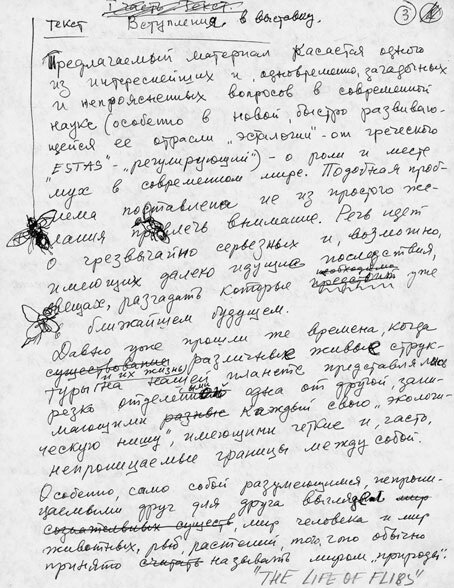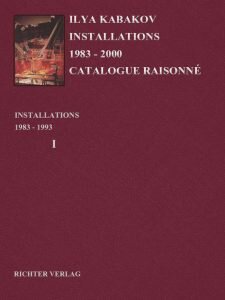The Life of Flies
YEAR: 1992
CATALOGUE NUMBER: 56
PROVENANCE
Consisting of the installations No 3, 12, 40, with additional rooms
The artist
1996, The Flies, Tabular Poetry (Room 3), Collection Robert and Melissa Soros
NOTES
See No 3, 12, 40
Not preserved as installation in this form
EXHIBITIONS
Cologne, Kölnischer Kunstverein
Ilya Kabakov. Das Leben der Fliegen, 2 Feb 1992 — 29 Mar 1992
New York, Barbara Gladstone Gallery
Ilya Kabakov. The Life of Flies, 1 Mar 1997 — 5 Apr 1997
DESCRIPTION
The installation The Life of Flies was built in the Kunstverein in Cologne in January 1992. The long space of the Kunstverein is divided into 4 halls which form a suite.
The first hall is thematically divided into sections: 1) Flies and the Economy; 2) Flies and Finance; 3) Flies and Politics; 4) Flies and Fine Arts. The materials of the first three sections are located on two slanted tables, material of No. 4 is on the walls. In the beginning of the viewing, there is a pillar on which is affixed a glass case with a fly lying in the middle of a small structure.
Second hall: The theme ‘The Civilization of Flies’ is located in this hall. In the middle of the hall on the other side of a barrier, the viewer sees two structures hanging in the air made from 500 flies that are arranged in a special way. Along the walls are two stands with explanations and sketches and one glass showcase with exhibits.
The third hall is devoted to two themes: ‘A Concert for A Fly’ and ‘The Flies’, ‘Tabular Poetry’. On the long wall to the right of the entrance hangs a large painting (2.60 X 4 meters) and to the right of it are 40 drawings–commentaries that accompany this painting.
In the corner of the opposite wall, there is something like a concert going on. Closer to the corner there is a fly hanging in the air (cut out of paper and colored) and around it is arranged an amphitheater, music stands with texts and notes standing on them. Besides these, on these same pages, there are drawings. The fly here, as often happens in chamber orchestras, is performing the role of both the conductor leading the musicians and a soloist playing along with them.
This final hall is devoted to the theme ‘The Fly as a Subject and Basis for Philosophical Discourse.’ The entire installation consists of one large drawing of the fly (55 X 45) and 132 pages of typed text, each page of which is encased in a glass frame. The installation was intended especially for the ‘White Hall’ of the Pushkin Museum in Moscow, and therefore the installation will be described for this dwelling. The layout of the ‘White Hall’ is similar to that of an ancient church and in the wall opposite the entrance, there is a semi-circular indentation resembling a distinctive altar where there might be located a sculpture or in general the most important work of this hall. It is precisely in this place on the wall that the drawing of the fly hangs in a thick dark-brown frame. On both sides of the fly are hung 60 commentaries, the comments of viewers about the exhibited drawing. The side walls of the hall are also filled with texts (each page in a separate Passepartout and under separate glass). Since all the texts are grouped into articles, there are larger intervals between each ‘group-article’ than between the individual pages. At the entrance into the hall hangs a poster of the exhibit on the right, and on the left a diagram of the exhibit.
A few words about the general atmosphere reigning in the installation The Life of Flies. The dwelling represents a series of halls in a boring, not heavily visited Soviet scholarly provincial museum with rather awful light. There are no windows, all of the expositions and texts are intentionally illuminated with dull yellow electric light-bulbs. The ceiling and lower part of the walls are painted gray, which are usually painted dark-brown in official offices. Everything together creates an atmosphere of hopeless boredom, a boredom about which it is said that ‘even flies die from it.’
Similar exhibits were arranged in our country under the banner ‘New Advances in Science and Technology.’ In particular, the slogans and epigraphs in large letters in the anteroom, as well as such epigraphs in the center of each hall, attest to this pathos of this ‘new,’ as well as the quotes from the classics of science above the doors leading from one hall to another.
CONCEPT OF THE INSTALLATION
A museum of local history in a provincial city: Oh, how much this says to each visitor, especially to a visitor from out of town, not knowing how to kill time, what to do with himself, not knowing anyone in the city, wandering around strange streets, who accidentally sees before him a plaque with the name of the museum on it! An old wing that hasn’t been repaired for a long time now, an old door, depressing silence in the entrance and either an employee or a guard stunned by the unexpected appearance of a visitor. Small halls, more like rooms (the museum is usually located in an old two-story merchant’s estate) semi-darkness, cleanly swept floors. Small windows with thick old blinds sparingly let in light; only your steps along the old floor-boards or the steps of another coincidentally wandering visitor can be heard loudly. But there is, even more, anguish here than on the empty and hot street. There are displays along the walls and in the center which invoke boredom and desperation by their mere appearance, an appearance of dead glass boxes occupying a small space. And it’s as though the exhibits displayed in them have been collected here specifically in order not to chase away the boredom, but to take it to its extreme: rocks of different sizes and colors, the horn of a goat, or perhaps of a ram. The exact same kind of horn is mounted to the wall opposite. An iron spoon, broken at the very handle. Three old, dark, half-broken clay pots. From the anguish and spasms of desperation seizing you, you walk, run, rush into the next hall. A tree stump painted gray is standing in a box filled with cotton. A rabbit is sitting on the tree. A branch of some tree is attached to the wall. The inscription: ‘Cherry orchards occupy 126 thousand hectares in the Lenin Region in 1954; 189 thousand hectares in 1955 …’ In the display case on the second shelf, there is a ‘budyonovka hat,’ a pointed helmet worn by Red Army Cavalrymen during the Civil War Years, 1918-1921. Below, on another shelf for some reason is a small black automobile. Again there is a door into the next room. But you don’t have the strength to go on, there is none left. You are at the very peak, at the limit of anguish.
… But in other, more well-equipped, better-illuminated museums, such as technical, entomological, paleontological, ‘history of your own homeland,’ – dense desperation also seizes you from the first second, not permitting you to concentrate on anything. You are in a cemetery, but the remains have not been covered over, they have not been buried. You are among small, tiny, or just the opposite, large, enormous pieces of past life which you could care less about. Next to these remains are drawings and texts telling what all of this relates to, what it used to look like in its past life. But you don’t believe it, you can’t fully believe, standing here, in the reality of this past. Perhaps if you were there, in the deserts, forests, mountains, where all of this was dug up, then your imagination could start to work and the miracle of resurrection could actually occur. But here, in these long and deserted halls, in this ‘kingdom of the dead,’ they don’t come to life, but rather you yourself become an impotent, meaningless corpse among them.
Images
Literature








